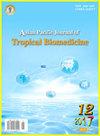G9a靶向的促性腺激素诱导癌症细胞焦下垂
IF 1.7
4区 医学
Q3 TROPICAL MEDICINE
引用次数: 0
摘要
目的:探讨催产素对胃癌细胞焦亡的影响及其机制。方法:采用台盼蓝染色法检测胃癌细胞的增殖情况。流式细胞术和Hoechst/碘化丙啶双染色检测细胞凋亡和焦亡。透射电镜观察细胞超微结构。Western blotting检测p-mixed lineage kinase domain-样(MLKL)、gasdermin- d (GSDMD)、gasdermin E (GSDME)、N-GSDMD、N-GSDME蛋白的表达水平。此外,采用乳酸脱氢酶(LDH)释放试验验证了催产素诱导的焦亡,并采用caspase 3抑制试验和siRNA干扰试验探讨了焦亡机制。结果:200 ~ 600 nmol/L浓度的催产素诱导胃癌细胞AGS、HGC27、MKN28、SGC7901细胞凋亡、凋亡,并呈剂量依赖性和时间依赖性。催产素处理后,SGC7901细胞的超微结构发生了显著变化,如染色质凝聚、空泡化、线粒体嵴断裂、核占用增加等。浓度为400 nmol/L的催产素显著增加了大鼠的细胞数量、LDH释放量和N-GSDME/ GSDME比值(P0.05)。结论:缩宫素除诱导胃癌细胞凋亡外,还通过caspase 3/GSDME途径诱导胃癌细胞焦亡。G9a是催产素诱导胃癌细胞焦亡的靶点。本文章由计算机程序翻译,如有差异,请以英文原文为准。
G9a-targeted chaetocin induces pyroptosis of gastric cancer cells
Objective: To evaluate the effect of chaetocin on pyroptosis of gastric cancer cells and its underlying mechanisms. Methods: The proliferation of gastric cancer cells was detected by trypan blue staining. Flow cytometry and Hoechst/propidium iodide double staining were used to detect apoptosis and pyroptosis. Cellular ultrastructure was observed by transmission electron microscopy. The levels of p-mixed lineage kinase domain-like (MLKL), gasdermin-D (GSDMD), gasdermin E (GSDME), N-GSDMD, and N-GSDME proteins were detected by Western blotting. In addition, lactate dehydrogenase (LDH) release assay was used to verify pyroptosis induced by chaetocin, and caspase 3 inhibition test and siRNA interference test were conducted to investigate pyroptosis mechanisms. Results: Chaetocin at concentrations of 200 nmol/L to 600 nmol/L inhibited the proliferation of AGS, HGC27, MKN28, and SGC7901 gastric cancer cells in a dose-dependent and time-dependent manner by inducing apoptosis and pyroptosis. Significant ultrastructure changes, such as chromatin condensation, vacuolization, disrupted mitochondrial cristae, and increased nuclear occupancy, were observed after treatment with chaetocin in SGC7901 cells. Chaetocin at a concentration of 400 nmol/L significantly increased the number of pyroptotic cells, LDH release, and the ratio of N-GSDME/ GSDME (P<0.01), which were reversed by Z-DEVD-FMK. In addition, chaetocin did not affect the expression of GSDMD. G9a silencing abolished the effect of chaetocin on the expression levels of GSDME and N-GSDME and LDH release (P>0.05). Conclusions: In addition to inducing apoptosis, chaetocin inhibits gastric cancer cells by inducing pyroptosis via the caspase 3/GSDME pathway. G9a was the target of chaetocin to induce pyroptosis of gastric cancer cells.
求助全文
通过发布文献求助,成功后即可免费获取论文全文。
去求助
来源期刊

Asian Pacific journal of tropical biomedicine
Biochemistry, Genetics and Molecular Biology-Biochemistry, Genetics and Molecular Biology (miscellaneous)
CiteScore
3.10
自引率
11.80%
发文量
2056
审稿时长
4 weeks
期刊介绍:
The journal will cover technical and clinical studies related to health, ethical and social issues in field of biology, bacteriology, biochemistry, biotechnology, cell biology, environmental biology, microbiology, medical microbiology, pharmacology, physiology, pathology, immunology, virology, toxicology, epidemiology, vaccinology, hematology, histopathology, cytology, genetics and tropical agriculture. Articles with clinical interest and implications will be given preference.
 求助内容:
求助内容: 应助结果提醒方式:
应助结果提醒方式:


